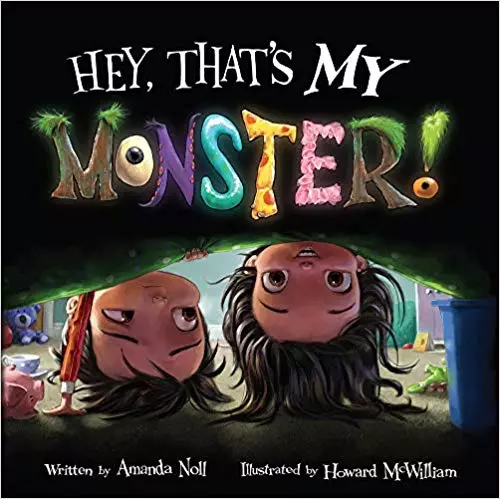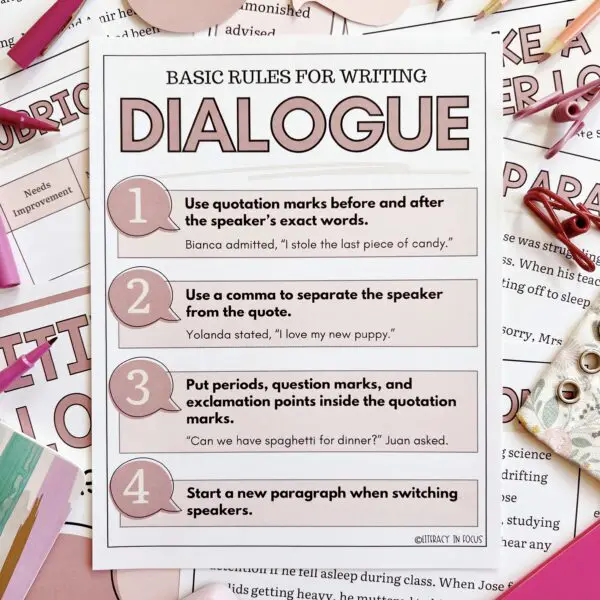
Teaching students how to incorporate dialogue into their narrative writing is not an easy task. There’s a lot that goes into the art of writing dialogue, and conveying all of the intricate details can get overwhelming fairly quickly. According to the Common Core State Standards, students in third grade and above are expected to be able to accurately use dialogue in their narrative writing. Since dialogue and narrative writing go hand-in-hand, it only makes sense to supplement narrative instruction with a lesson on how to effectively write dialogue. The cooperative lesson plan described below is extremely versatile, and it gets the job done. By the end of the lesson, you will know which students need additional help with writing dialogue and which students have mastered the skill.
Pre-Lesson Inventory
Prior to starting the dialogue lesson, it is helpful to take a quick inventory of what your students already know. Do they know what the term dialogue means? Do they know why dialogue is used? Taking part in a short oral discussion will allow you to gauge what you need to cover before diving into the dialogue lesson. If necessary, define the term dialogue, think of synonyms, and place the term in context by using it in a sentence. After clearly defining the term, discuss with students the importance and use of dialogue. Talk about how dialogue brings the narrative to life and adds depth and complexity to the characters. When students have a clear understanding of the meaning and use of dialogue, move on to the anticipatory activity.
Anticipatory Activity
The dialogue writing lesson begins with an activity that gives students immediate insight into the purpose and use of dialogue. Find two short pieces of text, one that does not include dialogue and one that does. You can use a passage from a student novel or children’s book. Simply remove or add dialogue to meet your needs. Start with the text that does not include dialogue. Read it together as a class. Next, read the text that includes dialogue. Orally compare the paragraphs by posing the following questions to students:
- What is different about the texts?
- Which text was more interesting to read? Why?
Dialogue Notes
When students have a reasonable grasp of why dialogue is used, it’s time to tackle the how. Jumping right into notes on dialogue punctuation and format will provide students with a strong point of reference when needed later in the lesson. The following four dialogue rules are adequate for most grade levels.
- Use quotation marks before and after the speaker’s exact words.
Bianca admitted, “I stole the last piece of candy.”
- Use a comma to separate the speaker from the quote.
Yolanda stated, “I love my new puppy.”
- When dialogue ends with a period, question mark, or exclamation point, put the punctuation inside the quotation marks.
“Can we have spaghetti for dinner?” Jason asked.
- Start a new paragraph when switching speakers.
Click the button below to download the FREE Dialogue Rules Anchor Chart.
Mentor Text
According to Lynn Dorfman, co-director of the Pennsylvania Writing and Literature Project, mentor texts are pieces of literature that you can return to and reread for many different purposes. They are texts to be studied and imitated. In terms of dialogue, I Need My Monster and Hey, That’s My Monster! by Amanda Noll work extremely well as mentor texts. Students love the storyline, and all the rules of dialogue are clearly portrayed. Noll replaces “said” with a variety of different words including rasped, coaxed, and sniffed, encouraging students to get creative with word choice. Reading the story twice, once before guided instruction and then again before the independent assessment will provide students with a clear and concrete example of dialogue format and punctuation.
I Need My Monster by Amanda Noll 
Hey, That’s My Monster by Amanda Noll 
Guided Instruction
After reviewing dialogue examples in the mentor text, guide students through the dialogue writing process using example sentences. Put practice sentences on the board or create your own worksheets for students to add punctuation. After students have added dialogue punctuation to the practice sentences, review as a class for accuracy. Two example sentences are provided below.
Incorrect Sentence: Get out of my room screamed Jenny
Corrected Sentence: “Get out of my room!” screamed Jenny.
Incorrect Sentence: The teacher announced The quiz will be tomorrow
Corrected Sentence: The teacher announced, “The quiz will be tomorrow.”
Synonyms for Said
Before moving on to the group activity, guide the class in a brainstorming activity producing synonyms for the word said. If time allows, students can search through books to find words authors use in place of said.
Cooperative Writing Practice
After brainstorming replacements for the word said, place students in groups to complete the cooperative portion of the dialogue writing lesson. First, pass out a paragraph of text that does not include dialogue to each group. Again, you can use passages from a student novel or children’s book. Simply remove the dialogue before giving the passage to students. Next, students work together, adding dialogue to the text. In order to be successful, students should pull from what they have learned thus far in the lesson. To do so, they will need access to their dialogue notes, practice sentences, and the synonyms for said list. Assess students as they are rewriting the paragraphs to ensure understanding and accuracy. The goal is for students to be able to independently add dialogue to their narrative writing.

Independent Assessment
At this point in the lesson, students should be prepared to complete an independent dialogue writing assessment. Provide each student with a paragraph that does not include dialogue. Instruct students to revise the paragraph to include the correct use of dialogue. If you’re using a dialogue writing rubric, review the grading criteria before starting the assessment. Example grading criteria for dialogue writing are listed below.
- Quotation marks are used before and after the speaker’s exact words.
- When necessary, a comma is used to separate the speaker from the quote.
- Punctuation is placed inside quotation marks.
- A new paragraph is started when a new person is speaking.
“Perfect introduction to our narrative writing unit! Thank you!” -Julie C.
This post contains affiliate links. Click here to read my affiliate policy.






